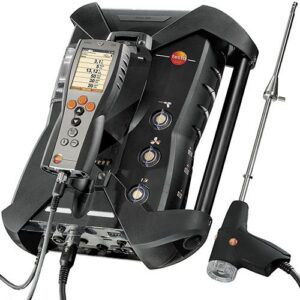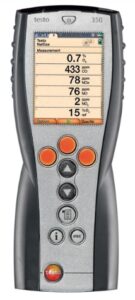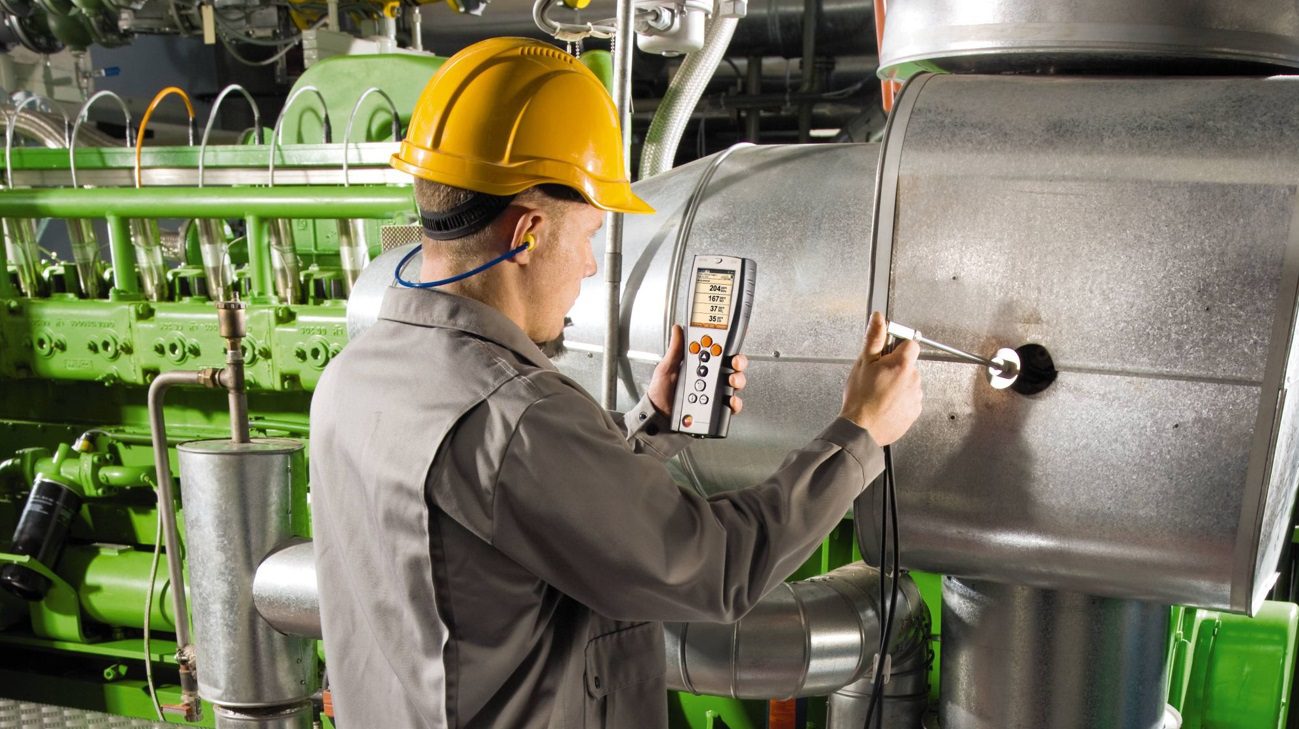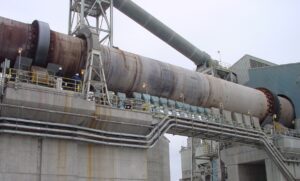Performing flue gas analysis in accordance with AS1375, AS3814, and AS5601 Gas Appliance (Type B) Standards for increased Combustion Efficiency
Introduction
Flue gas analysis is not just a technical procedure; it’s a vital lifeline in the heart of industrial gas operations and combustion efficiency. This meticulous process stands at the crossroads of safety, efficiency, and environmental stewardship, playing a pivotal role in optimising the performance of industrial gas appliances.
Whether it’s a kiln on a gold mine in the Goldfields of Western Australia or a power station in Perth, the implications of flue gas analysis stretch far beyond the confines of the facility.
For instance, a flue gas analysis strategy which GENEX recently implemented for a power generation client of ours, has returned improved operational efficiency of 7% based on improved combustion solutions, a reduction in fuel consumption, this has had a knock-on effect with reduced emissions, and an increase in combustion efficiency (thermal efficiency), and even prolonged equipment life expectancy.
This simple example showcasing the profound impact on both business outcomes and environmental health. Such instances underscore why flue gas analysis is more than a regulatory compliance step; it’s a strategic tool essential for modern industrial success. In Australia, adhering to standards like AS1375, AS3814, and AS5601 isn’t just about following rules—it’s about pioneering a future where industrial efficiency coexists with environmental responsibility.
The Science of Combustion Efficiency & Flue Gases
Fuel gas emerges from the combustion process, carrying the reaction products of fuel and combustion air. These gases typically contain particulate matter, sulphur oxides, nitrogen oxides, and carbon monoxide. The process of combustion, fundamentally, is the rapid oxidation of fuel producing heat and light.
In industrial settings, combustion gases are initially termed “exhaust gases.” After transferring their heat to absorbing surfaces and moving through the gas path and out of the flue or exhaust stack.
The Stoichiometric Point, or ‘ideal combustion’, occurs when the available oxygen precisely converts all carbon into CO2, without excess or deficiency. The objective in combustion processes is to approximate this ideal combustion as closely as possible.
Much like a pathological test for humans, flue gas analysis serves as a preventive measure to check the performance of fuel used for combustion. During this analysis, components such as Oxygen, Excess Air, Carbon Monoxide, Carbon Dioxide, Oxides of Nitrogen and Sulphur, Ambient Temperature, and Flue Gas Temperature are measured.
The Process of Flue Gas Analysis
Flue gas analysis is conducted by inserting a probe into the flue of a boiler, furnace, or similar appliance. This is typically done between the last heat exchanger and the draft diverter, or near any source of make-up air that enters the flue but didn’t pass through the combustion process. This analysis helps in detecting the concentration of different gases, thereby enabling the regulation of the burner for optimal performance. It’s essential for evaluating air-to-fuel ratios in combustion processes to achieve the best efficiency.
Parameters in Flue Gas Analysis
GENEX considers the following parameters while performing flue gas analysis:
| Ideal Measurement | Acceptable Range | |
| Oxygen (O2) | 4.2 % | 4.2 – 10 % |
| Carbon Dioxide (CO2) | 12.5 % | < 12.5 % |
| Carbon Monoxide (CO) | 0 ppm | < 400 ppm |
| Excess Air | 23 % | 20 – 40% |
| Nitrogen Oxides (NOx) | 0 ppm | 25 – 100 ppm |
| Sulphur Oxides (SOx) | 0 ppm | 0 ppm |
There are other factors which come into play, temperature, gas rate etc. But the exhaust gases are pivotal in creating a clear picture of appliance health and a combustion efficiency or lack of.
Enhancing the Role of Flue Gas Analysis | Why Flue Gas Analysis Matters
Flue gas analysis involves meticulous monitoring and examination of the gases emitted from industrial gas appliances during the combustion process. This analysis is essential for several reasons:
- Efficiency Assessment & Optimisation: flue gas analysis helps determine how efficiently a gas appliance is burning fuel. By analysing flue gases, technicians are able to determine the required adjustments to ensure maximum combustion efficiency. This involves making adjustments to the appliance to achieve complete combustion, minimising fuel consumption and reducing operational costs.
- Environmental Compliance: industrial emissions are subject to stringent environmental regulations. Emissions Testing helps ensure that the levels of harmful emissions, such as nitrogen oxides (NOx), sulphur oxides (SOx), and particulate matter, are within permissible limits. This not only aids in environmental protection but may also be part of the environmental license to operate.
- Safety Assurance: improper combustion can lead to the accumulation of dangerous gases like carbon monoxide (CO). By analysing flue gases, gasfitters and equipment owners can identify any anomalies or issues in the combustion process early, ensuring the safety of the workforce and preventing potential accidents.
- Equipment Longevity: consistent monitoring and adjustment of the combustion process can reduce the wear and tear on industrial appliances. This prolongs the equipment’s lifespan and reduces the need for frequent repairs or replacements.
Responsibilities of Gasfitters & Equipment Owners
Gasfitters and equipment owners must adhere to the following responsibilities regarding flue gas analysis, as per the mentioned standards:
- Gasfitters should have the necessary training and equipment to perform flue gas analysis accurately.
- Equipment owners are responsible for ensuring that flue gas analysis is conducted as part of routine maintenance and following the installation of new appliances.
- Both parties must maintain records of flue gas analysis results, repairs, and adjustments, as this documentation is essential for compliance and safety.
When Should Flue Gas Analysis Be Carried Out
Flue gas analysis should be conducted at specific times in the life cycle of a gas appliance.
- Initial Commissioning: when a new gas appliance is installed, flue gas analysis provides a baseline assessment of its combustion performance. This ensures that it is operating efficiently and safely from the outset. In accordance with the ‘Typical Commissioning Procedure’ outlined in AS1375 Appendix H.
- Routine Maintenance: regular flue gas analysis during routine maintenance checks helps monitor the appliance’s ongoing performance. It can reveal any deviations from optimal combustion conditions that may require adjustment. Direct-fired heaters or unflued appliances shall have flue gases analysed at least every six months, according to AS1375 Table B2 – Typical Test Schedule for Combustion.
Procedure for Testing Flue Gases of an Industrial Gas Appliance
To ensure the optimum efficiency of an industrial gas turbine, a systematic and thorough procedure for testing flue gases should be implemented. This procedure not only ensures efficiency but also helps in maintaining environmental compliance and safety standards.
Preparation
- Ensure Appliance Readiness: confirm that the gas appliance is operating under normal load conditions. The appliance should be at its typical operating temperature and settings representative of typical operating conditions.
- Gather Necessary Equipment: verify that the flue gas analyser is calibrated, functions correctly, and suitable for the type of gas appliance being analysed. Ensure all other necessary tools and equipment are available and in good working condition.
Accessing the Flue System
- Flue Accessibility: ensure that the flue or exhaust stack is accessible and safe for sampling.
- Selection of Sampling Points: Choose an appropriate sampling point that provide a representative sample of the combustion gases. These points should ideally be located where the gases are well-mixed. The location of the sampling point is important because, the analysis needs to occur as close to the combustion chamber as possible but far enough away to allow the chemical combustion processes to occur. AS3814 Clause 2.1.10 Provision to be made for sampling flue gases – Provision shall be made for obtaining samples of flue gas for analysis.
Sampling
- Probe Insertion: carefully insert the sampling probe of the flue gas analyser into the flue or exhaust stack.
- Gas Collection: collect a gas sample for analysis. Ensure that the sample is representative of the overall combustion process.
- Record flue gases (as far as is practical) at the following stages of combustion:
- Start gas
- Main gas (Low, Mid and High Fire).
Analysis
- Measure Key Parameters: use the flue gas analyser to measure various parameters including:
- Oxygen (O2)
- Carbon Dioxide (CO2)
- Carbon Monoxide (CO)
- Nitrogen Oxides (NOx)
- Excess Air
- Combustion efficiency
- Flue gas temperature.


- Analyser Use: follow the manufacturer’s guidelines for using the flue gas analyser and interpreting the results. GENEX use the Testo 350 Flue Gas Analyser, it a brilliant piece of equipment, easy to use and accurately measures every parameter we require. Testo provide training on setting up flue gas tester.
Data Recording & Analysis
- Record Findings: document the measured values for each parameter, including the date and time of analysis. Document any deviations from recommended or required levels and note any safety or efficiency concerns. Refer to previous flue gas analysis records for comparison reference.
- Assessment: evaluate the data against standard performance metrics for the turbine. Look for signs of incomplete combustion, such as high CO levels or poor efficiency.
Adjustment & Optimisation
- Make Adjustments: based on the analysis, adjust the gas appliance settings to optimise combustion. This may include tuning the air-to-fuel ratio or modifying operational parameters.
- Repeat Testing: after adjustments, conduct another round of testing to confirm that the changes have improved combustion efficiency and reduced harmful emissions. Repeatedly analyse and adjust as needed until desired parameters are achieved.
Reporting & Follow-Up
- Documentation: maintain detailed records of all tests, adjustments, and maintenance activities.
- Reporting: report any significant findings or deviations from standard operating parameters to the appropriate management or maintenance team. Record keeping is important. Results in isolation are nowhere near as valuable as a series of test reports over a period.
- Regular Maintenance: incorporate flue gas testing into regular maintenance schedules to continually monitor and optimize turbine performance.
Compliance & Standards Adherence
- Regulatory Compliance: ensure all testing and adjustments comply with relevant environmental and safety regulations.
- Standards Adherence: follow any industry-specific standards or guidelines, such as those set by local or international regulatory bodies, for gas turbine operation and emissions.
By following this structured procedure, the efficiency and safety of an industrial gas appliance can be effectively monitored and optimised. Regular and meticulous flue gas analysis is key to maintaining high performance and compliance with environmental standards.
AS1308, AS5601, & AS1375 Requirements
In Australia, several standards govern the maintenance and operation of gas appliances, and they include specific requirements related to flue gas analysis:
AS1375 – Industrial Fuel-Fired Appliances
The Australian Standard AS1375, titled “Industrial fuel-fired appliances,” primarily focuses on the safety and efficiency requirements for industrial gas appliances. The purpose of this standard is to provide comprehensive guidelines and requirements to ensure that these types of appliances are designed, installed, and operated safely and efficiently.
Key aspects of AS1375 include:
- Safety Requirements: the standard outlines essential safety measures to prevent accidents and hazards associated with the operation of industrial fuel-fired appliances. This includes measures to control risks of fire, explosion, and exposure to harmful emissions.
- Efficiency Guidelines: AS1375 also provides guidelines on how to achieve and maintain optimal operational efficiency in industrial fuel-fired appliances. This is important not only for cost-effectiveness but also for environmental considerations.
- Installation and Maintenance Procedures: it details the procedures for the correct installation and regular maintenance of these appliances. Proper installation and maintenance are crucial for ensuring both safety and efficiency.
- Emission Control: the standard includes specifications for emissions to minimize the environmental impact of these appliances. This is particularly relevant considering increasing environmental regulations and concerns about air quality.
- Performance Testing: AS1375 also includes guidelines and procedures for performance testing to ensure that the appliances meet the required safety and efficiency standards throughout their operational lifespan.
In essence, AS1375 serves as a comprehensive guide for manufacturers, installers, and operators of industrial fuel-fired appliances, ensuring that these appliances are safe, efficient, and environmentally responsible.
AS3814 – Industrial & Commercial Gas-Fired Appliances
This standard provides guidance on the installation and maintenance of gas appliances. It emphasises the importance of conducting flue gas analysis during initial commissioning and routine maintenance to ensure appliances operate efficiently and safely.
The Australian Standard AS3814, known as “Industrial and commercial gas-fired appliances,” is specifically designed for the safety, operation, and maintenance of gas-fired appliances used in industrial and commercial settings. This standard provides comprehensive guidelines and requirements to ensure that these appliances are safely installed, maintained, and operated.
The key objectives of AS3814 include:
- Safety Requirements: AS3814 details essential safety measures for the operation of gas-fired appliances in commercial and industrial environments. This includes guidelines for the prevention of fire hazards, explosions, and risks associated with gas leaks or improper combustion.
- Installation Guidelines: it provides specific requirements for the correct installation of gas-fired appliances. Proper installation is crucial to ensure the safe and efficient operation of these appliances.
- Maintenance Protocols: the standard sets out maintenance procedures to ensure ongoing safety and operational efficiency. Regular maintenance is vital for detecting potential issues before they become serious hazards.
- Operational Efficiency: AS3814 also focuses on optimizing the operational efficiency of gas-fired appliances. Efficient operation is essential for reducing fuel consumption and operational costs, as well as minimizing environmental impact.
- Emission Standards: the standard includes specifications regarding emissions from gas-fired appliances, aligning with environmental regulations and concerns about air quality and public health.
- Performance Testing and Compliance: it outlines methods for testing the performance of gas-fired appliances to ensure they meet the specified safety and efficiency standards.
In summary, AS3814 is a critical standard for the safe and efficient use of gas-fired appliances in industrial and commercial settings in Australia, covering aspects from installation and maintenance to safety and environmental compliance.
AS5601 – Gas Installations Part 1: General Installations
The Australian Standard AS5601.1, titled “Gas Installations – General installations,” is a comprehensive standard that provides guidelines and requirements for the installation of gas systems, including piping, appliances, flueing, and associated equipment used for natural gas, LP Gas, or biogas installations.
Its primary purpose is to ensure safety, reliability, and compliance in the installation of gas systems in residential, commercial, and industrial settings. It mandates that gas appliances must be installed and maintained to operate efficiently and produce minimal emissions. Flue gas analysis is essential to assess compliance with these requirements.
Key objectives of AS5601.1
- Safety Guidelines: the standard outlines essential safety requirements to prevent hazards such as gas leaks, fires, and explosions associated with gas installations. This includes detailed procedures for safe installation practices to protect installers, users, and the public.
- Design and Installation Specifications: AS5601.1 provides comprehensive specifications for the design and installation of gas systems. This covers aspects such as material selection, sizing of components, and proper connection methods.
- Testing and Commissioning: the standard includes protocols for testing and commissioning gas installations to ensure they are safe and operational before being put into service.
- Ventilation and Flueing Requirements: proper ventilation and flueing are critical for gas appliances to operate safely. AS5601.1 provides guidelines on how to achieve adequate ventilation and flueing to remove combustion products and supply sufficient air for combustion.
- Compliance with Regulatory Requirements: adherence to AS5601.1 helps ensure compliance with local and national building codes and regulations related to gas installations.
- Environmental Considerations: the standard also considers environmental aspects, ensuring that gas installations are designed with consideration for their environmental impact.
- Consumer Protection: By standardizing installation practices, AS5601.1 also serves to protect consumers by ensuring that gas installations are reliable, efficient, and safe.
In summary, AS5601.1 serves as a vital reference for gas fitters, engineers, and other professionals involved in the installation of gas systems, ensuring that these installations meet high standards of safety, efficiency, and regulatory compliance.
Combustion Performance
Flue gas analysis should be conducted in accordance with AS3814 Clause 3.6 – Combustion Conditions.
Record flue gases (as far as is practical) at the following stages of combustion:
- Start Gas (in compliance with AS3814 Clause 3.2.3)
- Main Gas (Low fire, Mid fire, High fire) (in compliance with AS3814 Clause 3.6.10.
Stoichiometric Ratio
The theoretical ratio of fuel to air which allows complete combustion to occur. Complete combustion is when all the fuel and Oxygen are burnt in the combustion chamber. For Natural Gas the Stoichiometric ratio is 9.55 (Oxygen) : 1 (NG). At the Stoichiometric point, no Carbon Monoxide (CO) is produced.
At the Stoichiometric point, the following theoretical values will be present:
| Natural Gas | LPG |
| Heat Energy = 38MJ
Oxygen (O2) = 0% Carbon Monoxide (CO) = 0% Carbon Dioxide (CO2) = 12% Nitrogen Oxides (NOx) = 700 ppm Lambda Ratio = 1.00 |
Heat Energy = 96MJ
Oxygen (O2) = 0% Carbon Monoxide (CO) = 0% Carbon Dioxide (CO2) = 13.7% Nitrogen Oxides = 700 ppm Lambda Ratio = 1.00 |
(ƛ) Lambda Ratio
Lambda represents the ratio of Oxygen actually present in a combustion chamber, compared to the expected amount for ‘ideal combustion’ (Stoichiometric combustion) to occur. Thus, when the mixture contains exactly the amount of oxygen required to fuel present, the ratio of oxygen and fuel is one-to-one (Lambda =1.00).
- If the mixture contains too much Oxygen (lean mixture), Lambda will be greater than 1.00.
- If the mixture contains too much Fuel (rich mixture), Lambda will be less than 1.00.
Oxygen (O2)
The Oxygen (O2) level should be checked to ensure levels of excess air are at least 4.2% minimum. Determine Oxygen levels in accordance with AS3814 Appendix F3 – Parameterizable systems that do not require a low Oxygen limit device, states that if the appliance does not have an Oxygen sensor in the flue, that excess air should be set to a minimum of 23% and/or Oxygen set to minimum of 4.2%.
Carbon Monoxide (CO)
Representation of complete combustion. According to Australian Gas Appliance Standards, CO (Carbon Monoxide) levels SHALL be less than 400 ppm (exceptions for gas turbines and engines).
Carbon Dioxide (CO2)
High levels of CO2 could be an indication of efficient combustion. At the Stoichiometric point, the ideal concentration of CO2 is:
- Natural Gas = 12.5%
- LPG = 13.7%
Refer to AS1375 Graph G1 for levels of Carbon Dioxide and Oxygen for ideal combustion.
For natural gas the ideal values at 23% excess air are:
- Oxygen (O2) = 4.2%
- Carbon Dioxide (CO2) = 10%
CO / CO2 Ratio
The CO/CO2 ratio should not exceed 0.02 for an open flued appliance. When Oxygen level are at 0%, Carbon Dioxide is approximately 12.5%. As the O2 levels increase, the CO2 levels decrease.
Remembering that O2 should be at or above the minimum of 4.2%. At this level CO2 is approximately 10%.
Nitrogen Oxides (NOx)
NOx refers to the mixture of Nitric Oxide (NO) and Nitrogen Dioxide (NO2).
Air consists of approximately 79% of Nitrogen. Nitrogen doesn’t add anything to the combustion process no work in the combustion process. As it passes through the gas path, it absorbs heat from the flame and lowers the temperature and adversely affects thermal efficiency. Furthermore, Nitrogen reacts with Oxygen under high combustion temperature which forms NOx, a harmful gas.
Because gas turbines and gas reciprocating engines have such large amounts of excess air, they should be checked against the amount of Nitrogen Oxides (NOx) they produce. Typically, this would be 25 ppm to 100 ppm, but may depend on the Environmental Licence of the facility. Reciprocating lean burn engines are typically 600 ppm.
Excess Air
Excess Air is supplied to ensure satisfactory combustion and cools the combustion chamber to prevent the formation of NOx, measured in Parts Per Million (ppm).
Conclusion
Flue gas analysis is a fundamental aspect of gas (Type-B) appliance maintenance and safety. It helps ensure efficient combustion, identify safety issues, and comply with environmental regulations.
AS3814, AS1375, and AS5601 provide clear guidelines for gasfitters and equipment owners on when and how to conduct flue gas analysis, by following these standards and best practices, we can ensure the safe and efficient operation of gas appliances.



